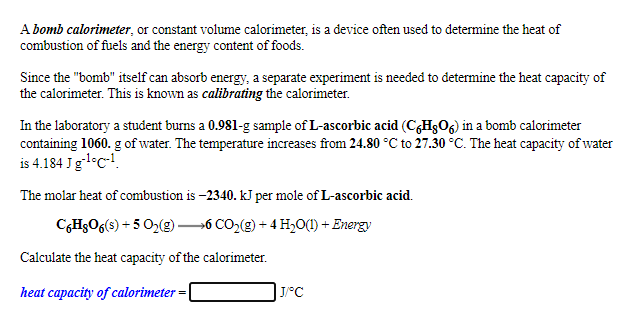A bomb calorimeter, or constant volume calorimeter, is a device often used to determine the heat of combustion of fuels and the energy content of foods. Since the "bomb" itself can absorb energy, a separate experiment is needed to determine the heat capacity of the calorimeter. This is known as calibrating the calorimeter. In the laboratory a student burns a 0.981-g sample of L-ascorbic acid (CgHgO6) in a bomb calorimeter containing 1060. g of water. The temperature increases from 24.80 °C to 27.30 °C. The heat capacity of water is 4.184 Jgl-c•!. The molar heat of combustion is -2340. kJ per mole of L-ascorbic acid. C,H2O6(s) + 5 O,(g) -6 CO,(g) + 4 H,O(1) + Energy Calculate the heat capacity of the calorimeter. heat capacity of calorimeter - | J/°C
A bomb calorimeter, or constant volume calorimeter, is a device often used to determine the heat of combustion of fuels and the energy content of foods. Since the "bomb" itself can absorb energy, a separate experiment is needed to determine the heat capacity of the calorimeter. This is known as calibrating the calorimeter. In the laboratory a student burns a 0.981-g sample of L-ascorbic acid (CgHgO6) in a bomb calorimeter containing 1060. g of water. The temperature increases from 24.80 °C to 27.30 °C. The heat capacity of water is 4.184 Jgl-c•!. The molar heat of combustion is -2340. kJ per mole of L-ascorbic acid. C,H2O6(s) + 5 O,(g) -6 CO,(g) + 4 H,O(1) + Energy Calculate the heat capacity of the calorimeter. heat capacity of calorimeter - | J/°C
Chemistry: Principles and Reactions
8th Edition
ISBN:9781305079373
Author:William L. Masterton, Cecile N. Hurley
Publisher:William L. Masterton, Cecile N. Hurley
Chapter8: Thermochemistry
Section: Chapter Questions
Problem 88QAP: A sample of sucrose, C12H22O11, is contaminated by sodium chloride. When the contaminated sample is...
Related questions
Question

Transcribed Image Text:A bomb calorimeter, or constant volume calorimeter, is a device often used to determine the heat of
combustion of fuels and the energy content of foods.
Since the "bomb" itself can absorb energy, a separate experiment is needed to determine the heat capacity of
the calorimeter. This is known as calibrating the calorimeter.
In the laboratory a student burns a 0.981-g sample of L-ascorbic acid (CH3O6) in a bomb calorimeter
containing 1060. g of water. The temperature increases from 24.80 °C to 27.30 °C. The heat capacity of water
is 4.184 Jglc!.
The molar heat of combustion is –2340. kJ per mole of L-ascorbic acid.
C,HgO6(s) + 5 O2(g)6 CO,(9) + 4 H,0(1) + Energy
Calculate the heat capacity of the calorimeter.
heat capacity of calorimeter =
J/°C
Expert Solution
This question has been solved!
Explore an expertly crafted, step-by-step solution for a thorough understanding of key concepts.
Step by step
Solved in 2 steps with 3 images

Knowledge Booster
Learn more about
Need a deep-dive on the concept behind this application? Look no further. Learn more about this topic, chemistry and related others by exploring similar questions and additional content below.Recommended textbooks for you

Chemistry: Principles and Reactions
Chemistry
ISBN:
9781305079373
Author:
William L. Masterton, Cecile N. Hurley
Publisher:
Cengage Learning

Chemistry
Chemistry
ISBN:
9781305957404
Author:
Steven S. Zumdahl, Susan A. Zumdahl, Donald J. DeCoste
Publisher:
Cengage Learning

Chemistry for Engineering Students
Chemistry
ISBN:
9781337398909
Author:
Lawrence S. Brown, Tom Holme
Publisher:
Cengage Learning

Chemistry: Principles and Reactions
Chemistry
ISBN:
9781305079373
Author:
William L. Masterton, Cecile N. Hurley
Publisher:
Cengage Learning

Chemistry
Chemistry
ISBN:
9781305957404
Author:
Steven S. Zumdahl, Susan A. Zumdahl, Donald J. DeCoste
Publisher:
Cengage Learning

Chemistry for Engineering Students
Chemistry
ISBN:
9781337398909
Author:
Lawrence S. Brown, Tom Holme
Publisher:
Cengage Learning

Chemistry: Principles and Practice
Chemistry
ISBN:
9780534420123
Author:
Daniel L. Reger, Scott R. Goode, David W. Ball, Edward Mercer
Publisher:
Cengage Learning

General Chemistry - Standalone book (MindTap Cour…
Chemistry
ISBN:
9781305580343
Author:
Steven D. Gammon, Ebbing, Darrell Ebbing, Steven D., Darrell; Gammon, Darrell Ebbing; Steven D. Gammon, Darrell D.; Gammon, Ebbing; Steven D. Gammon; Darrell
Publisher:
Cengage Learning

Chemistry & Chemical Reactivity
Chemistry
ISBN:
9781133949640
Author:
John C. Kotz, Paul M. Treichel, John Townsend, David Treichel
Publisher:
Cengage Learning